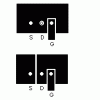I think I asked this before a year ago but I don't remember anymore (and have some slightly new problems).
How do people pass motor-level currents (~50A) on a PCB? Some of the RC ESCs are tiny and they pass a huge amount of amps. Granted they use huge arrays of MOSFETs so they have large areas of copper, but still...some of these pass 100A.
I was told to solder wire onto the PCB, but the problem is the current still passes through the PCB between where the wire is soldered and the component pad since I can't solder them right on top of each other due to spacing (plus it's really messy even if I could).
I could get 8oz boards made fairly cheaply...the catch is that I'd need to get 155 square inches of it made. Costs $~320 so it's pretty good, but that works out to be 10-20 boards. And they have to be double-sided to have this much copper so it's not like I can route the needed logic circuits onto it as well and panelize it all.
How do people pass motor-level currents (~50A) on a PCB? Some of the RC ESCs are tiny and they pass a huge amount of amps. Granted they use huge arrays of MOSFETs so they have large areas of copper, but still...some of these pass 100A.
I was told to solder wire onto the PCB, but the problem is the current still passes through the PCB between where the wire is soldered and the component pad since I can't solder them right on top of each other due to spacing (plus it's really messy even if I could).
I could get 8oz boards made fairly cheaply...the catch is that I'd need to get 155 square inches of it made. Costs $~320 so it's pretty good, but that works out to be 10-20 boards. And they have to be double-sided to have this much copper so it's not like I can route the needed logic circuits onto it as well and panelize it all.

